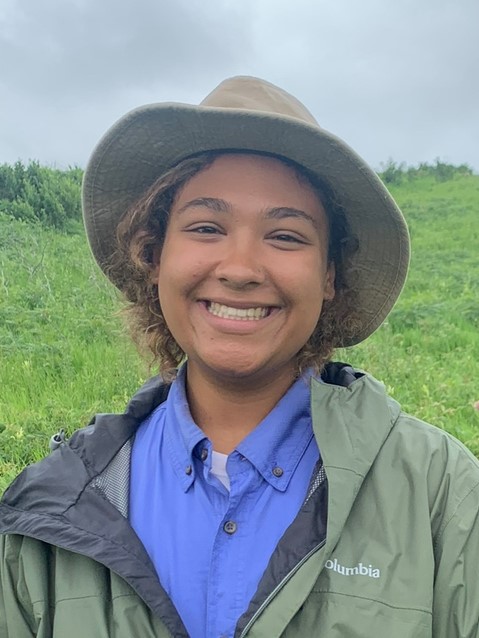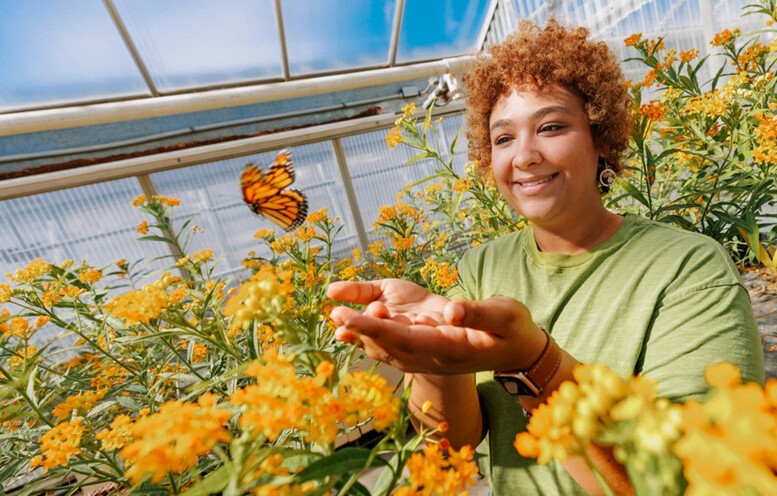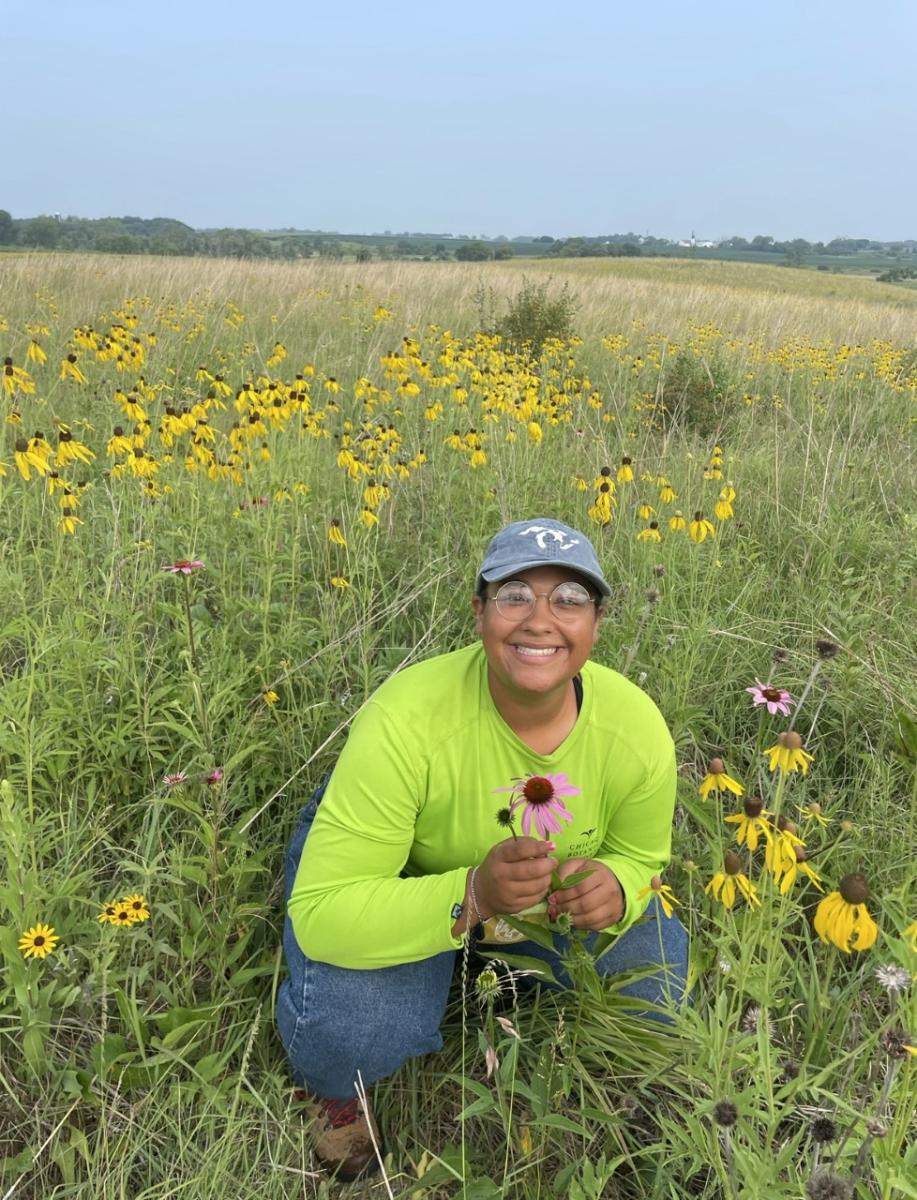Advisor(s): Kristi Montooth, Ana Vélez Arango

Taking flight in conservation ecology with butterflies
Miyauna Incarnato has discovered that studying monarch butterflies is not for the faint of heart.
For one thing, the eastern monarchs she is studying in her doctoral research at Nebraska are hard to track. The orange-and-black beauties breed four to five generations in a year, with successive generations migrating from Mexico to Canada and back again. Depending upon where and when they are born, the butterflies live for different lengths of time. Only adults live in Mexico, and they are thought to live eight to nine months, mostly in diapause. Butterflies hatched from eggs laid along the migration route may live only a few weeks. How does a two-legged scientist in Nebraska track all of that?
Complicating matters further, monarch populations have rapidly declined since the mid-1990s, with a recent Mexico count estimating decline at 85 percent. Monarchs are now on the waiting list to be considered for Endangered Species Act protection.
Seeing both the peril that monarchs face in the wild and the need to understand them better, Incarnato decided to take monarch caterpillars bred in the lab of her home department, the School of Biological Sciences, and experiment with them outdoors.

“Rearing monarchs outside is difficult, but I didn’t want to jeopardize wild populations by removing valuable monarchs from them,” she says.
She built cages and put them and the lab caterpillars outdoors, something she had not heard of being done before.
In a trial run in the spring, she put 15 caterpillars out on milkweed, the only plant they eat, under a cage on a prairie outside Lincoln. All 15 survived to adulthood.
In the summer and fall, she placed 150 caterpillars at six sites, with each site having five cages with five caterpillars in each. Three of the sites were within Lincoln, including an East Campus site, and three were in prairies outside Lincoln.
“What we actually saw, some of my more preliminary results, is survival was significantly higher at prairie environments,” Incarnato says.
Prairie monarchs also grew larger than urban monarchs and had more eggs in their ovaries.
However, the overall survival rates to adulthood for the caged monarchs were much lower than in the lab, where it averages 60 percent. The prairies sites averaged about 38 percent survival, and urban sites averaged about 13 percent.
Urban sites may have been watered, but prairie sites were not. When drought struck, the milkweed on some prairie sites died. Without healthy milkweed leaves to eat, the prairie caterpillars at those sites died.
“This isn't like a cut-and-dried which one is better,” Incarnato says of the prairie and urban sites. “It’s examining what are the consequences we're going to have to deal with in the different environments.”

Past studies have suggested monarchs are chiefly affected by temperatures and seasonal changes in the length of the day, Incarnato says. She plans to continue looking at these factors when she runs field and lab experiments over the next two years. She collected all the dead caterpillars, hatched butterflies and milkweed leaves to look at other factors like exposure to pesticides, fungicides, herbicides or bacterial disease.
Factors she cannot examine in her experiments include highway deaths and parasitoid wasps. Incarnato says past studies have suggested many monarchs die trying to migrate across large highways in Texas and Oklahoma.
Parasitoid wasps kill monarchs by laying eggs in them, causing them to “explode” when the eggs hatch, Incarnato says. Her cages kept parasitoid wasps out.
Squirrels were another matter. She discovered three cages knocked over and a hole chewed into one of them. Not to falsely accuse squirrels, but she did find a squirrel sitting atop one of her cages when she checked on it.
Then Nine-Mile Prairie caught on fire, and the fire ended about five feet from her cages.
None of this deterred her.
Incarnato sees the eastern monarch population as one the world cannot afford to lose, with the butterflies making up about 99 percent of all North American monarchs.
“If this species’ population continues to decline and is eventually lost, we really may be actually losing an entire genetic component important to their migration, and this is also the largest population that feeds into the populations across the world,” she says. “So, for the resilience of the monarch species, it's very important to both understand and make sure this larger migrating population isn't compromised.”
A smaller population of western monarchs migrates between the states of Washington and California, and eastern monarchs feed into that population, Incarnato says. Nonmigratory monarchs can be found around the world, in places like Columbia, Cuba, Puerto Rico, Australia and parts of Europe, and they are not necessarily in danger, she says.
For the imperiled eastern monarch, though, Nebraska is, as Nebraskans like to say, “in the middle of everywhere.”
“Nebraska is really midway,” Incarnato says. “So, we see a lot of a lot of monarchs throughout the entire season, versus way north they don’t see them until later in the summer in a much shorter period, which is why Nebraska is a really cool place to study monarchs. Right in the middle.”
Nebraska also is known for quick weather changes, which Incarnato says may help her better understand how temperature variance stresses monarchs.
“If it's too hot, and a monarch is like, ‘Whoa, it feels like June,’ but it's actually October, I'm concerned that maybe they won't get the environmental triggers to migrate back down to Mexico,” she says. “They will sit here, and then all of a sudden, it's freezing rain outside. They didn’t realize they had to go back.”
Other scientists have questioned how she will be able to draw conclusions about wild monarchs from lab monarchs. She has responded by adding another part to her experiments by breeding wild monarchs with the lab ones.
“You can’t say they are 100 percent the same, so I try to mitigate that by rearing them outside, but I'm also going to try to mitigate that even more by introducing wild monarchs into the lab population to introduce new genes into our lab population and do the experiment again with those,” she says.
The captured monarchs and their offspring will become lab monarchs, unsafe to return to the wild.
Looking toward her own future after she graduates, she says she would like to work at a place where she can do research and engage with the public. Possibilities she lists include working at a university, a nonprofit, a museum or an organization like National Geographic, where she interned in research last year.
She says she is more interested in conservation and its management than in a particular species.
“I really just think monarchs are an excellent way to understand that,” she says. “But so are bears.”
So, could she see herself working with bears?
“Honestly, yes,” she says. “It'll be interesting to see where the conservation world leads me.”
— Ronica Stromberg, NRT Program Coordinator


